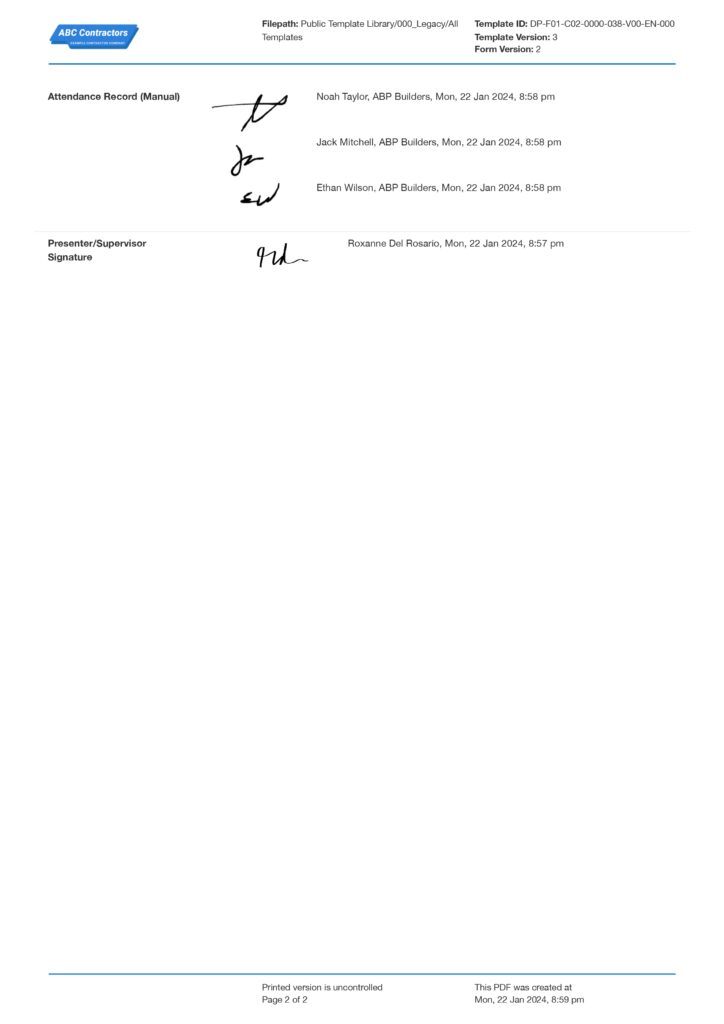Dashpivot Article – Safety Moment Dehydration
Safety Moment Dehydration
Water plays a vital role in our lives, especially when we work. With that, we must avoid dehydration at all costs in the workplace. In this article, we will be discussing how to avoid dehydration in safety moment settings and share a free safety moment form that you can use.

The Importance of Discussing Dehydration in the Workplace
Water is a vital human necessity. It is essential to drink water, since it plays many important functions in our body to keep us alive. A few of these important functions of water are to bring nutrients to cells, remove waste, protect organs and bones, and regulate body temperature. With this said, the intake of water must be done more frequently when doing strenuous activities and when under the weather. Doing this will help people avoid dehydration.
In the workplace, dehydration is rarely discussed among workers, since it is always underestimated compared to other visible hazards. Hazards like fire hazard, fall hazard, and equipment hazards seem to be a more organisational concern, while dehydration for most seems like a personal responsibility. However, what many don’t realise is that dehydration is a real threat to workers. It can lead to serious health risks, which also increases the risks of other hazards. A good place to discuss this is during the safety moments meeting, which is an avenue to formally discuss the risks that come along with dehydration.
Safety Moment Topics on Dehydration
Now that we have discussed the importance of why we should talk about dehydration in the workplace, we will now delve into some important topics related to dehydration that you can use to discuss in your safety moments. Including dehydration-related topics in your safety moments can directly provide a positive impact on the health of all workers.
Recognising dehydration and its symptoms
Dehydration is one ailment in the workplace that is often overlooked. Establishments often prioritise more on apparent hazards that are found in the everyday operations of work. However, dehydration has the potential to cause many different safety and health hazards. To remove this practice of complacency, companies should properly discuss what dehydration is, its effects, and its symptoms. Having awareness about dehydration is the first step to acknowledging its dangers and what the personnel can do to avoid it. Emphasising this on the safety moments, especially on dehydration symptoms, can provide employees with the knowledge of the proper measures to be done to avoid dehydration.
How much water should you drink daily?
The popular practice on how much water a person should drink in a day is 2000 millilitres per day, or equivalent to 8 glasses of water. However, due to more modern studies, this has been changed (although still a reasonable and acceptable practice for staying hydrated). According to the U.S. National Academies of Sciences, Engineering, and Medicine, an adequate daily fluid intake is 3.7 litres for men (15.5 cups) and 2.7 litres for women (11.5 cups). But fluid intake may be adjusted if needed depending on the daily activity being done, the environment the person is in, overall health condition, and pregnancy. Having this on the dehydration safety moments can help your employees do good practice in drinking water.
Electrolytes and how they aid hydration
Electrolytes are substances that, when dissolved in water, have a natural electrical charge that corresponds to either a positive or negative charge. Electrolytes are found in almost every fluid and cell in your body since the average adult's body is composed of around sixty percent water. In addition to other functions, they assist your body in regulating chemical processes, preserving the healthy balance between fluids within and outside of your cells, and more. With that said, electrolytes aid you by retaining water in your body, helping cells absorb sufficient water, and ensuring proper function of muscles in your body. That is why most electrolyte drinks are almost always associated with sports and heavy activities.
Hydration Myths and Facts
There are myths around the world about drinking water. One popular and common belief is that when your urine is dark yellow, that means you're already dehydrated. While this can sometimes be true, the truth is that it is not always the case. For example, drinking multivitamins can inevitably turn your urine dark yellow no matter how much you drink water. Urine colour can be an indication of multiple things. It can be because of something you consumed or drank, or some underlying conditions in your body.
With this example right here, we can say that it is always important for people to distinguish facts from myths, for some myths can be a source of bad practice, which can lead people to conditions like dehydration. Showing your workers about facts and myths can guide them on what appropriate practices should be done to achieve sufficient levels of hydration.
Dehydration and heat stress
Dehydration is a common cause of heat stress. Heat stress when the body’s mechanism to regulate its internal temperature begins to fail. One of the important roles of your bodily fluids is to regulate your body temperature. When dehydrated, sweat production is reduced, therefore compromising the natural mechanism that your body uses to cool down. Other than your sweating, when you are dehydrated, cardiovascular strain is imminent due to making your heart work harder to circulate blood to cool your body. This can lead to dizziness, fatigue, and a higher risk of heat-related illnesses. Discussing dehydration being a cause of heat stress definition and heat stress awareness are important topics to be discussed in your safety moments, especially for environments that are above normal temperatures.
Water, sugar water, and caffeine
Companies should also specify what constitutes a suitable and unsuitable water replacement for this discussion. Employees often mistake other fluids for their own hydration, which may sometimes result in dehydration. This may be understood by defining suitable water alternatives during your safety moments discussion. However, this does not imply that you should use such a beverage in lieu of water entirely. Only in the event that water is unavailable or inaccessible should this be done. Here are a few examples of healthy water alternatives: milk, herbal teas, coconut water, and natural fruit juice.
Health-related illness due to dehydration
To further help employees understand the dangers of dehydration, discussion of its health effects can be done in your safety moments meeting. Here are some examples of those ailments that resulted from dehydration:
Constipation: Dehydration happens when the body does not have enough fluids to operate when it should be functioning properly. An infrequent bowel movement or trouble passing stool are two of the symptoms that are associated with the illness known as constipation. Constipation may be caused by dehydration, despite the fact that the two conditions may seem to have no connection to one another. When the body is dehydrated, it attempts to conserve water by absorbing fluids from the intestines in order to get more water. Because of this, the faeces become dry and hard, which makes it harder to pass, which ultimately leads to constipation.
Brain Function Problems: Although this may be impacted by individual variations related to activity levels and dehydration tolerance, studies have indicated that cognitive performance degrades with modest water loss of around 2% body water loss. However, this can be altered significantly by individual variances. Negative mood swings, increased response times, problems with short-term memory, and decreased focus are some of the symptoms that might be experienced. There is a possibility that such a little loss of water from the body might occur merely as a consequence of ordinary everyday activities, particularly in individuals who drink just around one litre of water (or four cups' worth) on a daily basis.
Kidney Problems: The gain receptors in the brain begin to detect a shortage of water in the blood and produce antidiuretic hormone for those who are continually losing water in their skin, lungs, kidneys, and stomach. This indicates that the body is experiencing a lack of water in the blood. The kidneys are prompted to reabsorb more water as a result of this. In the event that a person is extremely dehydrated, they run the risk of developing acute kidney injury (AKI), which is characterised by an abrupt reduction in kidney function. Because of this, waste materials have the potential to accumulate in the bloodstream since the kidneys are not able to filter them out of the body as efficiently as they normally would.
Running a safety moment on dehydration to raise critical awareness
You can see a good example of a safety moment form below.

Use this free Safety Moment format for your dehydration safety chat
A Digital Approach to Safety Moment Talks and Ideas
A safety moment is a great platform to talk about safety and health in the workplace. Making a safety moment by hand, however, might be a bit time-consuming. The constant printing and reformatting can be a little frustrating if it is done more often. Additionally, making these forms by the pen-and-paper method requires you to open a lot of computer applications to make a form and record the contents of the form. This consumes a lot of time and is highly prone to human error.
With the Dashpivot Safety Moment App, you can use a digital form, which you can create using a sophisticated form builder, or simply choose a pre-made form from one of the app template library's free safety moment idea templates. You may also use the digital file without worrying about the internet. While on the field, you can use the Safety Moment Talk app while offline. Once you have supplied the necessary data from your meetings, you can just save the file and upload it later when the internet is available.
Any completed or pre-made safety moment meetings may also be easily located, updated, or converted into a professionally created PDF document online, where they are automatically structured and kept.
To do all of these and more, use the Dashpivot safety moment app. For further information, click this link: The Dashpivot app for Safety Moment.

Heat Stress Toolbox Talk
Avoid heat stress incidents with PPE, prevention and identify symptoms using this Toolbox Talk Heat Stress template.

Safety Improvement Plan
Create coherent, actionable and professional safety plans using this proven framework

Toolbox talk
This toolbox talk template is quick and easy to complete and signoff on site, and keeps all of your toolbox talks neatly organised and professional.

